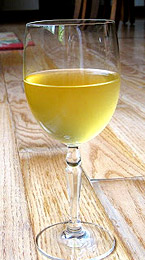 I racked and filtered my Pinot Grigio and it was crystal clear when I bottled it. Now, some bottles (but not all) have a white almost milky sediment in the bottom of the bottles and it has a slightly “dirty sock” aftertaste. I’ve been told it was a protein and I might be able to remove it with Sparkolloid but have not tried it yet. Any suggestions?
I racked and filtered my Pinot Grigio and it was crystal clear when I bottled it. Now, some bottles (but not all) have a white almost milky sediment in the bottom of the bottles and it has a slightly “dirty sock” aftertaste. I’ve been told it was a protein and I might be able to remove it with Sparkolloid but have not tried it yet. Any suggestions?
Name: Neal C.
State: CA
Hello Neal,
Normally, when someone tells me they have a milky/dusty/silty substance at the bottom of their wine bottles, I tell them that they either bottled their wine too soon — before everything had a chance to clear out completely — or that the wine started slightly fermenting again while in the bottle.
But something you have explained has changed this whole scenario: that is the fact that you have filtered the wine. I’m assuming that when you say filtered, you mean that you put the wine through an actual wine filter and didn’t just strain it through some cheesecloth or similar.
Filtering the wine would have taken out anything that could have caused a visible sediment later, so having the sediment caused by particles that were still suspended in the wine at bottling is out of the question. Filtering would have also taken out a huge chunk of the yeast cells that may have remained in the wine, so a re-fermentation is highly unlikely, as well.
What this means is that what you are seeing is something that was created after the wine was bottled. It wasn’t from microscopic particles still in the wine. It wasn’t from a re-growth of yeast cells. It was from something that was precipitated out of the wine while in the wine bottle.
Precipitation occurs when there is more of a particular compound in a liquid than the liquid can hold. Instead of staying dissolved or saturated within the liquid, it releases as a solid substance.
By far, the two most common substances to precipitate from a wine are tartaric acid and tannin. Tartaric acid will precipitate as little crystals, about the size of popcorn salt or smaller. It may look white, but is more likely to be beige in color. Tannin precipitates as a powdery substance, about the consistency of flour. It can be white in color, but it is more likely to be beige, or in the case of a red wine, rose colored.
Based on your description I would say that you have a tannin precipitation problem. I would also like to point out that the person that said it was protein was correct. That’s because tannin is a protein. And like that person said, I would also recommend putting the wine back into a common vessel and treating it with Sparkolloid, with only one difference. I would also treat the wine with Bentonite, beforehand. Both are fining agents.
One other thing I would recommend is that after pouring the bottles of wine back into a fermenter you should immediately treat the wine with sulfites such as sodium metabisulfite. This will drive the oxygen out of the wine that was just introduced through the splashing. Once the wine has been successfully treated with the Bentonite and then the Sparkolloid, you will want to treat the wine again with sulfites and bottle right away.
Finally, you may want to take a look at the following article that is listed on our website: Maintaining Temperature Stability In Your Wine. This article goes over the precipitation issue in much great detail than I can here: how to determine it; how to prevent it.
Happy Winemaking,
Ed Kraus
———————————————————————————————————
Ed Kraus is a 3rd generation home brewer/winemaker and has been an owner of E. C. Kraus since 1999. He has been helping individuals make better wine and beer for over 25 years.

Unfortunately, you didn’t address the "dirty sock" part.I have made one of those kits and the person I gave it to said it was supposeds to smell like dirty socks! I think he used another term but—–. Will fining eliminate that taste?
Thanks for answering this question. I had the same experience with a couple of fruit wines that had tannin powder in the recipe, and now I know what that fine white powder on the bottom of the bottles was.
Bill, I do not believe that the "dirty sock" taste is related to the sediment in any way. This particular defect is normally associated with a wine that has cork taint or the cork was pre-soaked too much before being inserted into the wine bottle. It’s not likely that a fining will help this flaw, but I do not have specific experience in attempting to do so.
I find that these articals are extreamy helpfull